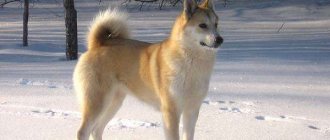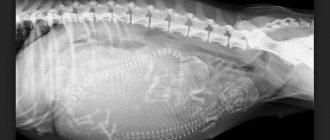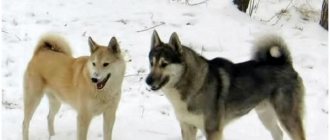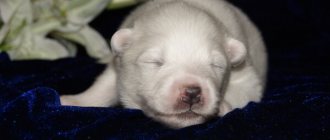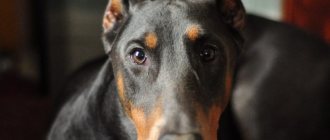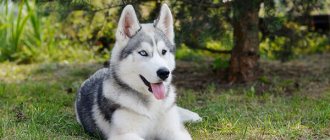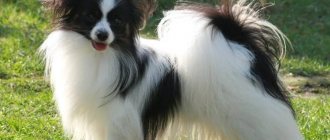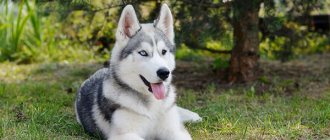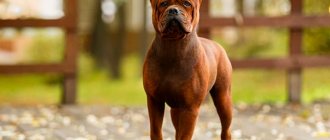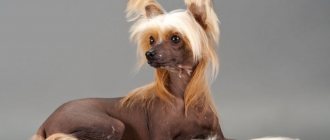Maintenance and care
Since this breed is classified as a hunting breed, its owners must constantly take care of its physical condition.
That is, you need to walk with her constantly and often, at least three times a day for about 60 minutes. During a walk, the animal should not just walk alongside, but follow some commands. Not a single day should go by without training. It perfectly develops muscles and maintains the vitality of an agility dog, various kinds of active games and even regular jogging. In order for a dog to be obedient, you need to not only run with it, but also constantly exercise it, even if the basic training course has long been completed. This will help you bond with your pet and constantly train his mind. Since the dog is smart and quick-witted, you can work with it constantly, each time learning something new and useful.
If you buy a husky not for hunting, then most likely the dog will feel unhappy and will definitely not please its owner. These animals depend on the opportunity to run around in the forest, they need space and enough space.
Regarding nutrition, everything is quite simple here. They need to be fed twice a day, preferably at the same time, but after a walk.
They are not particularly fussy about care; the main thing is to follow general recommendations so that the animal looks well-groomed and beautiful.
What you need to know about care:
Wool. Since huskies have a rich coat with a thick, dense undercoat, you will have to groom it regularly. They shed twice a year, during which time the fur comes off in large clumps. To prevent your dog from looking untidy, you need to brush it regularly using a special brush and the additional use of a slicker brush. The rest of the time, it is enough to just comb it a couple of times a week with a special mitten. Bathing a pet is often not recommended, since its fur has a special natural coating that protects the dog from pollution and natural disasters. Of course, if your pet is going to visit an exhibition, then you simply cannot do without water procedures. However, this must be done correctly and always using professional cosmetics. During drying, the wool must be lubricated with a special softening conditioner.
Eyes. The weakest point of huskies is their eyes. During hunting, dogs often injure them; also, during a fast run, dirt and other forest debris can get there.
Therefore, after hunting, it is important to immediately check your eyes and clean them of dust and dirt. At the first signs of an inflammatory process, it is recommended to gently wipe your eyes with chamomile decoction and apply anti-inflammatory drops
If the inflammation does not go away for a long time, you need to contact a veterinarian.
Ears. It is advisable to examine the ears as often as possible, especially if the dog is a working dog. They should be free of damage and signs of infection. If suddenly something like this is discovered, you should immediately seek help from a specialist. You need to clean your ears about once a week, using cotton pads and a special ear cleaning lotion. You can also wipe the inside of the ear with a regular damp cloth.
Claws. As a rule, these animals wear off their claws while running, however, there are times when you need to do this yourself. The claws are trimmed with special scissors; you can also use a nail file. If you don’t have the skills to trim claws, then it’s best to seek help from a specialist so as not to injure your four-legged friend’s paws.
Teeth. Teeth require regular and careful care, as the breed is prone to plaque and tartar formation. As a preventative measure, you can give your pet special treats and brush his teeth twice a day.
Veterinarian. To avoid health problems, it is recommended to visit your veterinarian regularly and regularly vaccinate your pet according to the established vaccination schedule.
Owner reviews
lobno
Advantages:
Low maintenance, friendly dog
Flaws:
Very active and curious.
The dog is very affectionate towards its owners and children, very mobile, adapted to live on the site, and is not afraid of frost. You won't get bored with such a dog; she loves children. They don't like heat. They are unpretentious in food and enjoy eating cherries, apples, and grapes. Does not require special care.
Diana3999
Hi all! A couple of months ago we got ourselves a West Siberian Laika! In general, we wanted to give her to her father in a private home, but he is in no hurry to take her away yet! At first we were scared, how to keep such a dog in an apartment! My husband and I read a bunch of sites on how to raise a dog. The first month was really hard! She peed and pooped all the time wherever she wanted and whenever she wanted! None of the methods described on the Internet help, and they spanked my butt and trained me to use the tray - it’s useless! In addition, they write everywhere that puppies pee until they are six months old! But it turned out that the dog is quite smart! Already now (she is three months old) she is asking to go outside! This is truly progress!
Regarding crying at night, we haven’t encountered such a problem at all, the animal sleeps peacefully at night, and if it doesn’t sleep, it lies down and doesn’t make noise, in general, both we and the neighbors sleep peacefully.
By the way, he sleeps only on his rug in the hallway, doesn’t poke his head on the sofa or bed, and if he tries to put his paws on, he is strictly stopped, but never jumps on.
In principle, there is no big problem with barking in the house either, she only barks when someone calls us on the intercom and then with a strict “no” she becomes silent or begins to make all sorts of funny sounds, somehow we need to splash out the joy!
She’s not picky about food at all, we feed her cereal, milk, kefir and yogurt when we buy for ourselves, we give her eggs, vitamins, dry food only as encouragement, basically. And, of course, meat for animals.
Of course, you can’t do it without training and teaching commands! He constantly begins to feel like a leader, so we teach commands every day! She already knows perfectly well the command to take place: sit, lie down, give me a paw, no, look, come to me. when we go to nature, we let him off the leash, he doesn’t run far, he’s always within sight and runs up on the command “to me.”
She doesn’t run up to people, we weaned her off that. While he periodically pulls on the leash during walks, he mostly understands that we don’t like it and walks next to us.
Loves children! We have nephews (7 and 5 years old), so they play with her all the time, she doesn’t bite them (puppies have a habit of biting their hands), the leash doesn’t pull at all when they walk with her, it’s just where they go and she follows.
He doesn’t interfere with eating while we eat, he calmly waits for his turn.
Well, we take her out into nature twice a week so she can run and bark to her heart’s content!
Of course, she’s still enjoying her childhood! But it's a puppy! In two months, we have already gotten used to it and it doesn’t cause so much trouble!
Cons: we can’t leave him at home even for a minute, he squeals and howls like a pack of wolves at home. We are afraid that the neighbors will start arguing, the walls are now being made thin! Thank God you can take it with you everywhere! We are planning to start teaching him to stay at home alone soon, when he is a little older, so that there will be less stupidity, otherwise we are afraid the apartment will be destroyed.
Victoria
Yes, I just love them!
Pachaeva Sofia04
Advantages:
A very good dog.
Flaws:
stubborn.
If you need a furry, energetic, curious one. loving friend, then this is a West Siberian Laika. This is a very energetic dog. If you want to get one, then you will have to walk it in the field at least once a month. Also, if you need another family member, then this is, of course, this dog. She loves children and adults very much, but is wary of passers-by and strangers. But you may also encounter difficulties because this breed is very stubborn and you need to be patient.
Alunika
Hello. I got a dog of this breed in July 2000 as a one and a half month old puppy. She was bought at the Bird Market for one and a half thousand rubles, as a maintenance puppy. There was an unscheduled mating, there were no documents.
At first, she looked like a wolf cub: all gray with bluish eyes. And what a tail it was! Like a pig! Only with a white tassel at the end. A barking pattern began to appear on the face and the eyes turned brown. The fur on the tail grew and the tail began to curl like a donut. They called it Jet.
Personality: independent and freedom-loving. An absolutely unkind dog. She's only licked me a couple of times in her entire life. Afraid of nothing...
Intelligence and intelligence: everything is in order here. But she grew smarter in steps: at 3.5 years; then at five, and then when the heat ended, after 7 years. Understood phrases and individual words; could correlate them with the time of day. For example: in response to my words “Jeta, Aunt Lena will come,” she rushed to the door and barked, but only if it was daytime. This trick did not work in the evening or in the morning. (Lena is a neighbor and her daughter’s English tutor; classes always took place after lunch).
Health: vaccinations were given only in childhood. We didn't do it every year. For the last year and a half of my life I was very sick. They treated me: they injected me with antibiotics, did an ultrasound, IVs, oxygen. The last days of her life they injected her with painkillers every day and took her to the clinic. Oncology in the liver with metastases; I was already thinking about putting her to sleep, but she left on her own... She lived for 17 years and three more days.
Problems encountered:
- I made “puddles” in the apartment for up to a year. Neither the newspaper nor anything saved. He can sit wherever he wants... For example, on the bed...
- howled when I was alone...
- grinned at me... It was impossible to put a hand to her... But this happened when, after the birth of my daughter, we gave her to my father... She lived with him for about 8 months... After the heat ended, her character changed for the better.
- walking is hard. Especially a fragile woman. So she pulled me... And the dog’s weight was more than 30 kg... And mine was (was) a little more than 50 kg.
- If she was left alone at a young age, she had fun “putting things in order” in the apartment. It will climb everywhere and chew everything! She even lifted the linoleum on the floor and chewed out the backing... Well, and leather shoes... Then I had to completely re-cover the floor...
Conclusion: I do not recommend keeping huskies and similar dogs in city apartments, even three or four room ones. Even if you go to the dacha for the whole summer... And you need to sterilize! I regret that we didn’t...
Now, taking into account all the previous experience, we got a small dog. Now it weighs about 9 kg. We also bought it at the Poultry Market. They wanted it to look like a little husky: the ears were like a house; ring tail. And the fur coat is light. This is what they took. They named it Julie. Metis. And we were trained to use the litter box, so we don’t have any problems with the toilet... And we were sterilized after the first heat... But that’s a completely different story...
And most importantly: you need to love the dog!!! Don’t get angry, don’t hit, don’t get irritated... turn a blind eye to a lot of things... Pamper... Well, just like with an only child... A dog’s lifespan is very short...
PS While I was writing this review, tears came to my eyes several times... She has not been with us for three years...
chucha11111
Advantages:
so many
Flaws:
No
When purchasing this breed, look at the entire pedigree first, since this breed costs quite a lot. I think you won’t be very interested in adopting a puppy from some not very good wild animal hunters. Secondly, look at the color, would it be better if the dog gave itself away while hunting? I think no! So choose carefully and look at what type of hunting you need this breed for. If for winter hunting, then choose a lighter color. If for autumn hunting, then of course darker! I have 4 West Siberian huskies and I can tell you they all work very well both in winter and at other times of the year. I was hunting in the fall, and at 3 p.m. they caught a boar weighing 65 kg. This breed also loves children very much, of course how to raise them! Very good breed!!!
Video
History of the breed
Like other breeds of huskies, the West Siberian husky is descended from outsider wolves, the descendants of which were used by Khanty and Mansi hunters in Tsarist Russia. The official description of Russian huskies with a very confusing taxonomy of breeds based on the ethnographic principle proposed by A. A. Shirinsky-Shikhmatov was published in 1925. In 1939, temporary standards for five breeds of huskies were formulated and adopted at the All-Union Cynological Meeting, and targeted activities began on their breeding. Within the framework of the Zagotzhivsyryo and Tsentrosoyuz systems, about seventy state breeding nurseries for hunting dogs were created in 1942 with a planned population of 1,800 dogs of all breeds. In 25 nurseries, only huskies were bred; in 27 nurseries, the number of huskies predominated. Thanks to these nurseries, breeding material was preserved during the Great Patriotic War.
The Khanty (Ostyak) and Vogul (Mansi) Laika breeds, originating from local stocks from the forest areas of the Ob basin and the Northern Urals, differed from other breeds in their taller stature, harmonious build, balanced behavior, strength and endurance. In 1947, E.I. Shereshevsky proposed a new classification of huskies based on geography. This classification was based on the assumption that the crossing of local varieties occurs within a large geographical region. In 1952, a new classification of breeds was adopted, and in 1954 new standards for Laika breeds were approved: Russian-Finnish, Russian-European and West Siberian. Although the Ostyak and Vogul Laikas, combined into one breed, were close geographically and similar in terms of hunting conditions and, accordingly, in working qualities, experts even today distinguish the Khanty and Mansi types in the West Siberian Laika breed. As part of the original breeds, the West Siberian Laika inherits the gene pool of the Zyryan (Komi), Ural, Udmurd, Evenki, Lamuk, Nenets Laikas, as well as the infused blood of German Shepherds and even Dingoes.
It is believed that the breed in its modern form was created in the famous nursery “Red Star” on the orders of Stalin. Dog handler N.B. Poluzadov selected the best representatives for breeding work in the Urals. Work with the West Siberian Laika was carried out in the VNIIOZ nursery, in the nurseries of the Sverdlovsk, Moscow, Perm, and Novosibirsk regions. The breed was recreated mainly on the basis of outcrossing and linear breeding of the descendants of two males - Tayozhny and Dzhubara.
The West Siberian Laika, thanks to the combination of exceptional hunting abilities and the qualities of a companion dog, quickly gained authority among hunters, displacing the local offspring of Laikas. The dogs had an outstanding sense of smell, were hardy and fleet-footed, and were distinguished by their courage and tenacity in pursuing the beast. Moreover, unlike many primitive breeds, these huskies were famous for their affection for their owner and loyalty. The unusual appearance for huskies also played a significant role in the popularity of the breed. This breed was especially popular in the 60s and 70s of the 20th century, when the number of participants in breed exhibitions numbered in the hundreds, and the import of puppies amounted to thousands. West Siberian Laikas are popular in forested areas throughout Russia and are the most numerous of all Laika breeds. Its versatility has earned it recognition among hunters around the world. The Fédération Cynologique Internationale recognized the breed in 1980.
Historical summary
Speaking about the emergence of the breed, two time periods should be considered:
- several centuries of careful selection by the indigenous inhabitants of Siberia and the Urals of the hardiest dogs that showed outstanding working qualities during the hunt;
- selection of West Siberian huskies since the beginning of the 20th century by dog handlers in order to bring the breed to the same standard.
The breed is based on populations of dogs bred by representatives of the Mansi, Zyryan and Khanty tribes.
For many centuries, the indigenous population of the Urals and Siberia survived in the harsh conditions of the taiga due to the traditional crafts of the local residents, the main one of which was hunting.
Invaluable assistance in this matter was provided by the so-called “northern wits” - strong and unpretentious dogs, distinguished by an unquenchable passion for hunting.
From generation to generation, hunters selected the best huskies in terms of endurance and hunting qualities, not allowing weak individuals to produce offspring and even destroying them. They made sure that their dogs did not interbreed with representatives of other breeds. The result of their efforts pleases hunting fans even today: experts unanimously call the West Siberian Laika a universal hunting dog. And for good reason.
With it, they are equally successful in hunting birds and large animals, catching fur and waterfowl.
The formation of the breed was completed by the seventies of the 20th century, and in 1980 it was officially recognized by the International Association of Cynologists.
Diseases characteristic of the breed
This breed does not have any diseases unique to it. The husky's health is excellent. The animal recovers quickly and without complications from injuries received while hunting.
To prevent infection by ticks or lichen, the husky should be examined after each visit to the forest and contact with other animals. If you find an attached tick or a suspicious area of fur, you should contact a veterinarian.
The average lifespan of an animal is 10–14 years. An active lifestyle and proper nutrition will allow your pet to remain mobile and lively until old age.
Health
East Siberian huskies are distinguished by good health. The average life expectancy is 10-12 years, but there have been cases of longevity. Many dogs, with proper care and proper exercise, can live 14-15 years, remaining in excellent working shape.
Diseases
Laikas are not susceptible to genetic pathologies. But they are characterized by diseases associated with hunting activities:
- Leptospirosis. While walking or while hunting, a dog can eat a mouse and become infected with this disease. Or be bitten by a marten or weasel, which can also cause infection.
- Esophageal worms. While hunting, the East Siberian husky can catch and swallow a small rodent suffering from this infection. And thus she becomes infected.
- Snake bites. The viper is the enemy of huskies. Often the dog strives to enter into a fight with a dangerous opponent. A snake bite to the neck area is especially dangerous. The owner must have anti-snake serum with him. This will help save your pet from death.
Vaccinations
A healthy dog is the owner's concern. Carrying out routine mandatory vaccinations will protect your pet from dangerous fatal diseases, one of which is rabies. Owners of huskies are advised not to miss vaccination dates, as the dog is especially susceptible to diseases when in contact with wild animals. Before vaccinations, a number of preparatory measures must be taken:
- Expulsion of worms. Almost all puppies are infected with worms. Two weeks before the expected vaccination, dogs are given anthelmintics.
- Flea and tick treatment.
- A visit to a veterinarian who will give an opinion on your health status.
Complex vaccines allow you to simultaneously vaccinate your dog against a number of diseases. The Nobivak vaccine has proven itself well. The veterinarian selects an individual immunization schedule.
The standard schedule is:
- The first vaccination is at the age of 8-10 weeks. The dog is vaccinated against diseases such as canine distemper, adenovirus infection, parvovirus, parainfluenza.
- After 2 weeks, revaccination is performed.
- The third is after a complete change of teeth, usually at 6 months. The same vaccine is administered as at 8-10 weeks, plus anti-rabies serum is added.
- The next vaccination is at the age of 12 months. All previous vaccinations are completed.
Character
The West Siberian Laika is primarily a hunting dog. Those who are thinking about purchasing such a dog should understand its psychology, that it is a hunting Spitz.
This is an emotional dog that is not only extremely affectionate and devoted to its owner, but is very observant, knows its owner’s habits, mood and can often predict his intentions.
These dogs do not like being locked in an apartment or a cramped yard; this causes them stress and they may bark incessantly. If possible, the husky will try to undermine the fence or jump over it. This dog needs a lot of activity and freedom, it is not designed to live on a chain or in an enclosure.
If a husky meets another dog, it may get into a fight, since the latter does not belong to its pack. They do not fight for fun or to kill; they use fighting to clarify the hierarchy in the pack.
Fights between familiar huskies can occur over a favorite toy, food, or place. This is a good fighter, but not a killer, and attempts to make a fighting dog out of the Laika will not be successful. The Laika is accustomed to ignoring large domestic animals: goats, horses, pigs. However, small animals such as cats or rabbits trigger her hunting instinct.
It can be taught to respond to them, but it all depends on the upbringing and character of the dog. Although training gives good results, everything can change if the dog finds itself in a situation unknown to it.
By nature, the West Siberian Laika is a born hunter. However, her instinct is quite specific and she hunts for the sake of hunting, and not for the sake of killing an animal.
The best Doberman is adjusting
Mating
West Siberian huskies mature early. Estrus (first heat) occurs from six months to a year. But dogs are not bred that early. The optimal start for mating is from 15 months for males, from 18 months for females.
Only healthy, purebred dogs are allowed for breeding. The rest are discarded.
Pregnancy lasts 53-71 days and is easy. Dogs give birth on their own; caesarean sections are rarely performed. There are an average of 4-5 puppies in a litter.
Buy | sell
| I'll give it to good hands Moscow April 18, 2020 Domestic mixed-breed puppies, 2 months old, g/w, different colors, will grow to be of medium size, very affectionate, cheerful and sociable, waiting for a reliable… |
| I'll give it to good handsMoscowApril 5, 2020 Cheerful Butch is looking for a home! Age: 3.5 years. Weight: 34 kg. Height: 65 cm at the withers. Healthy, vaccinated, neutered. Temperament/character: choleric and extrovert. ... |
| I'll give it to good hands Moscow March 29, 2020 Beautiful mixed-breed husky puppies, 2 months old, very smart, domestic, different colors: gray, black, black and white. Very good dogs for a family with… |
| 10 Belgorod8 February 2019 West Siberian Laika puppies, born 12/21/19, two boys and two girls |
| 5000 NovosibirskOctober 11, 2018 Selling West Siberian Laechkas. Purebred. Parents are workers. D. r. 09/04/2022. |
| 5000 Krasnodar25 April 2018 Laika puppies, born on March 13th. 1 boy left -5000?, and 3 girls -3000? . Parents with a passport. Mom is pure white. I'll give in!!! |
| 40000 January 17, 2018 I am selling a male West Siberian Laika, date of birth November 17, 2016, origin (Zyar VPKOS No. 1987/11 - Umka St No. 391-1631/LZS) Male with character, ... |
| I'll give it to good handsMoscowDecember 10, 2017 Our dear Linda looks a little like a cute fox with a neat face and house-like ears. Linda is a West Siberian Laika mix. Very devoted... |
| I'll give it to good hands Moscow November 25, 2017 We present to your attention a West Siberian husky mixed breed named Chuk. Our Chuk looks like both his mother Laika and a real gray wolf. Special charm... |
| 12000 September 18, 2017 West Siberian Laika puppies with pedigree for sale. There are 4 males and 1 female in the litter. Parents at field tests have diplomas in bear, badger, ... |
| Norilsk27 August 2017 Husky puppies for sale. The West Siberian Laika is a Russian breed of universal hunting dog. A dog of average and above average height, strong, dry... |
| 13000 May 20, 2017 West Siberian Laika puppies for sale from working studs with a pedigree. Born on April 18, 2022. There are 3 males in the litter. and 3 females. Father is a worker... |
| I'll give 100 to good handsMoscowApril 5, 2017 I will give into caring and loving hands a very active, intelligent, kind and affectionate girl, a West Siberian husky mix. Age 5 months. Bonya has been processed... |
| 20000 Murmansk February 27, 2017 I will sell puppies with a pedigree (stamp and metric of the puppy). Born January 13, 2022. Working parents (confirmed by diplomas). Call for details. |
| 12000 Krasnoyarsk February 6, 2017 West Siberian Laika puppies for sale. The parents are of high breed, have EXCELLENT exterior grades, diplomas in bear, boar, badger, and squirrel. ... |
| 15000 ShaturaDecember 20, 2016 1. Breed: ZSL 2. Number of puppies (males/females): 2/2 3. Date of birth of puppies: October 23, 2016 4. Color: male No. 1: gray-red with white male No. 2:… |
| 1000 mating Podolsk November 8, 2016 Male ZSL for mating in Podolsk, Moscow region. From working parents. Works properly on squirrels. We can take two or three puppies. |
| matingBryanskOctober 24, 2016 Male Trans-Siberian Laika, with pedigree, age 2 years. |
| 12000 October 13, 2016 Laika puppies for sale. Breed: West Siberian Laika Number of puppies in the litter (males/females): 3/3 Date of birth of puppies: September 6, 2016 Color:… |
| 10000 September 12, 2016 I will sell West Siberian Laika puppies from working parents. Date of birth 08/22/2016 Parents are commercial hunting dogs, they work in the taiga fur... |
| Istra12 July 2016 wonderful puppies with excellent pedigree from real hunters. boys and girls. Inexpensive. Born May 30, 2016 |
| 5000 Novomoskovsk16 May 2016 Zapodnosiberian Laika puppies mom and dad with documents |
| 10000 KrasnoyarskMay 2, 2016 I will sell LZS puppies from working fur dogs. The puppies were born on March 25th. There are 2 males and 2 females in the litter. |
| I'll give it to good hands Kazan April 19, 2016 We will give a West Siberian husky puppy to our home. she is 1.5 months old, very cute. . . . . it's hard for her in the apartment |
| 10000 Krasnoyarsk April 7, 2016 I will sell Laika puppies from working, purebred Laikas. Puppies were born on February 20, 2016. Parents in the taiga work on sable, elk, badger and wood grouse. For sale… |
| 4500 Ryazan April 3, 2016 Selling puppies from working parents. bargaining is appropriate |
| 20000 Lyubertsy2 March 2016 5 puppies for sale, gray red color. Distribution of puppies, February 19. Father of the puppies p.ch. Grip line p.p.p.p. Zuban Vronsky A.Yu. bitch then male p.p. Vagaya… |
| matingKirovFebruary 25, 2016 We offer West Siberian Laika, male, 3 years old. Thoroughbred, with documents. |
| 1000 February 10, 2016 I sell West Siberian Laika puppies, born November 10, 2015. Parents are workers (ungulates, fur). Two bitches left. 8 (960) 545-98-11(Margarita) |
| matingSochiJanuary 27, 2016 |
Caring for your husky
The West Siberian Laika, which lives in an enclosure and regularly takes part in hunting, does not require special care. These animals are very unpretentious. The dog loses its old undercoat naturally, wading through thorny bushes in pursuit of the animal. The claws also grind down without human help.
What you should do regularly:
- check the dog for ticks upon returning from the forest, park, etc.;
- carry out deworming – once every 3 months;
- examine the ears, eyes, nose, visible mucous membranes - daily;
- wash with dog detergent – 2 times a year.
If the husky is a city dweller, regular combing will have to be added to these procedures. It is necessary to accustom a puppy to this from a very early age: the dog’s undercoat is thick and dense, so the procedure may not seem the most pleasant to the animal. You can use a furminator or a powder brush. Start with the head, then comb out the body, legs and tail.
Nutrition
Generations of dogs raised in the taiga have made the husky completely unpretentious when it comes to food. The only thing the owner will have to face is the choice between natural cereals and drying. Both options have their pros and cons.
Expert opinion
Anna Abramenko
An avid dog lover. Experience in veterinary medicine since 2009.
Ask a Question
When considering dry food manufacturers, you need to pay attention to the composition and quality of the ingredients. Laika is a very active dog and needs a lot of protein to restore energy lost during the day. Therefore, the food must contain at least 40% meat. Holistics and nutrition in the super premium category have this indicator.
Using natural food will allow you to independently control the composition of the feed. But its preparation takes a lot of time. You need to give your dog only fresh food, preferably preparing it daily. Otherwise, feeding West Siberian huskies will not be difficult for the owner.
Raw meat is a potential source of parasites. Therefore, before serving this dish to your dog, it must be slightly frozen.
Laika character
Owners and breeders of huskies talk about the character of their pets with particular enthusiasm; after listening to them, we can conclude that these dogs are excellent companions for their owners.
If you are also an avid hunter, then you will form an ideal tandem with such a pet. Indeed, these dogs are characterized as fairly balanced animals, but despite their serious appearance, they are very energetic and love to frolic with their owner. They treat people calmly and do not show unreasonable aggression, but if they are deliberately angered or teased, they can attack the offender. Laikas get along well with other dogs, do not offend small pets and love children very much.
These dogs are surprisingly friendly and friendly, despite their close genetic level to their wild ancestors - wolves. From them, huskies adopted only all the most useful and positive qualities, for example, a highly developed sense of pack. They include the owner, his entire family and other domestic animals living with them in the same house as part of their pack. Laikas become very attached to all members of the pack.
Such dogs tend to get used to the company of their person, which is why they have a hard time with forced separation from him, long loneliness and lack of attention. With inexhaustible optimism, huskies are ready to accompany their owner everywhere, as well as run and play with all family members. The Siberian Laika is characterized by an easy-going and accommodating disposition, and at the same time independence, but without a bit of assertiveness and perseverance.
This dog always strives to please its owner and fulfill everything he wants from it. But this feature cannot always be considered an advantage, because if a husky receives the wrong command while hunting, it will definitely carry it out, contrary to its hunting skills and instincts. Therefore, many hunters who know their pet well prefer not to annoy him with unnecessary commands and give him freedom of action during the hunt.
Best Dog breed Golden Retriever (35 photos)
The Siberian husky is quite difficult to scare or enrage, because its ancestors accompanied people when hunting even bears. These dogs know their worth, are confident in their skills and instincts, but unconditionally recognize human leadership and are ready to follow him in any situation. Laikas have intelligence and intelligence given by nature. They do not cause difficulties in training and learning commands, due to their innate predisposition to training.
How to choose a puppy
When choosing a puppy, you need to decide what it is for. If the future owner is an avid hunter, then you need to buy it from hunters. They will not only select the most suitable puppy, but will also give recommendations on training hunting skills. You should definitely familiarize yourself with the pedigree and work achievements of the parents, examine the appearance and study the medical documents of the baby. If you do not plan to show the dog at shows, you can purchase a puppy without a pedigree.
It is also advisable to study the description of the breed: some colors (marble, coffee and others) are considered defects. At 4 weeks, the baby’s ears are triangular, sharp, and deep-set; by 3 months they rise. You also need to choose a puppy with dark eyes. Light eyes most often darken with age, but it happens that they remain that way (light eyes are a defect). The coat is thick and soft, otherwise the dog will freeze in cold weather. Puppies are not lethargic and passive (this is a sign of illness).
It is very important to give a suitable nickname. For males, nicknames such as Adam, Thunder, Whirlwind are recommended, for females - Amanda, Naida, Taiga.
Features of feeding and diet
Representatives of this breed usually require little food, but they are sometimes found to be food lovers.
The metabolism of huskies is slightly different from other dogs. Like all northern dogs, they need a protein-fat type of nutrition, while other breeds are characterized by a protein-carbohydrate diet. Laikas easily digest protein-rich and even fatty meats without putting much strain on the liver. If you create the right diet for such a pet, it will always look good and delight its owners with its activity. First of all, you need to decide on the type of food; dogs can be fed with commercial ready-made food or natural food. Ready-made diets are very convenient; you don’t need to waste time buying ingredients and cooking, but it’s worth noting that the dog can quickly get bored with this type of food and refuse it.
The metabolism of puppies is usually adapted to the mother's diet, so it is worth checking with the breeder what food your pet's mother was fed.
With a natural diet, you should develop a diet taking into account the weight, age, activity and health status of the dog.
The following foods should be present in the husky's diet:
- Meat - 60-70% of the entire menu, beef is perfect. It can be raw or boiled, depending on your dog’s preferences. The meat should be cut into medium pieces; minced meat should not be given - it will lead to indigestion.
- Sea fish - alternates with meat. Before feeding, you need to boil it and remove all the bones from it.
- Boiled vegetables - 20-30% of the diet. Vegetables you should choose: broccoli, pumpkin, cabbage (cauliflower and white cabbage), green beans, zucchini, turnips, carrots.
- Cereals - no more than 10−20%. It is convenient to give them in the form of flakes, after filling them with hot water. Among the cereals, it is useful for dogs to consume buckwheat, millet and rice.
- Dairy products. They replace one of the feedings, best done in the morning. Yoghurts without dyes and additives, low-fat cottage cheese and kefir are good for dogs.
When feeding huskies, it is worth considering the animal’s load. If the dog spent the whole day lying down, then it is worth reducing its daily portion by about a third.
Selling huskies in Russia
East Siberian, West Siberian and Russian-European Laikas are recognized as one of the best hunting breeds in the world.
If you decide to purchase such a dog, it is best to contact breeders or specialized nurseries. Then you can get a puppy with high working skills, excellent exterior, from the best breeding dogs. Professionals use for breeding only healthy adults who regularly take part in hunting badgers, wild boars, elk and even bears.
Usually, puppies that have reached the age of one month are prepared for sale, but you can also find raised dogs of four, five and six months of age. Each dog is socialized, accustomed to interacting with people, has a good pedigree, is vaccinated and has a ready-made veterinary passport.
If you are wondering how much a baby husky will cost, it is worth considering that the price for them is quite dynamic. For example, puppies bred VSL from 2015 were sold for 10 thousand rubles, while for puppies from 2017 their owners already paid 20 thousand.
Laikas are quite versatile pets; they can perform not only the functions of a hunting dog, but also a faithful companion or a strict nanny for children. When choosing a pet, many hunters choose Siberian huskies, because this breed was bred in Russia, which is why such dogs are excellent for hunting and keeping in our weather conditions. The Laika has earned particular popularity among breeders and nurseries due to its high working qualities.
The homeland of the Siberian Laika is the Eastern and Western parts of Siberia, which is why representatives of this breed can easily withstand the harsh climate of our country. Such dogs are able to adapt to any conditions and take root well in an enclosure, a country house and even a city apartment. These dogs are friendly towards people, unpretentious and easy to train.
Description
Currently, huskies are considered one of the most famous and popular dogs. These are real workers, capable of performing a wide variety of services. Smart, fast and independent pets are the dream of many dog lovers.
If you want to get such a smart and loyal friend, then you should pay attention to the main characteristics of the representatives of the described breed
- In dogs of all varieties, the head has a special wedge-shaped structure.
- All huskies have high-set ears with sharp tips. They never hang.
- Another characteristic feature of dogs of this breed is the ring tail.
- The hair of huskies is very stiff. The coat is straight, without curls or waves. The undercoat is good and thick (it is thanks to it that huskies can easily withstand exposure to low temperatures without experiencing discomfort).
- In the neck area, the coat turns into a voluminous shaggy collar.
- The backbone of huskies is very strong and powerful. The muscles are well developed. Dogs are characterized by a stately, correct posture.
The characteristics of adult dogs of different types of huskies may differ. This applies to the height and weight of animals.
- West Siberian individuals usually weigh between 18 and 23 kg when mature. Their approximate height can reach 53-58 cm.
- No less common Yakut huskies weigh 23-30 kg. Their height is 53-56 cm.
- East Siberian animals weigh from 18 to 23 kg and grow to 56-64 cm.
- The Russian-European variety of the Laika weighs 20-23 kg, and its average height is 53-38 kg if it is a cable. If we are talking about a female, then her weight will range from 48-56 kg.
- Karelo-Finnish species of northern dogs weigh from 12 to 13 kg for males, and 7-10 kg for females. The height of a male is 42-48 cm, that of a female is 40-46 cm.
The coat of this breed is of medium length. In the neck and shoulder area, the coat grows more voluminous and thick, resulting in the chic, warm collar mentioned above.
The coat color of huskies can vary significantly. In most cases, there are carriers of mixed coloration, as well as gray-white or red fur coats. With similar colors, the nose will have a characteristic black color. If the pet is white-brown, then its nose will be light brown.
Breed characteristics
Like most representatives of primitive breeds, the West Siberian Laika has a highly developed pack sense. This means that the pet imagines the family where it lives as a pack. Laikas in a flock always have a clear distribution of roles in accordance with the hierarchical ladder, but the pet almost never shows a desire to take the place of leader.
West Siberian Laikas are unusually devoted to their family, they are very friendly towards everyone who lives in the same territory with them, get along well with children and do not enter into conflicts with pets. These dogs listen to their owner unquestioningly, carrying out the most ridiculous commands.
Usually this breed of dog is used for its intended purpose, as an excellent hunter, and the pet is kept in an enclosure. Harsh weather conditions are not a problem for the West Siberian husky; it can withstand bad weather well, and its thick coat protects it from frost.
The West Siberian Laika tolerates severe frosts well due to its thick coat.
With such content, the best character traits of the dog are revealed, as it fulfills its purpose, helping the owner to drive the animal. Hours of marching and chasing an animal allows the animal to release its energy and demonstrate its mental abilities.
Apartment living as a companion is not very suitable for this breed, since forced sitting indoors with a couple of walks in the nearby park is too difficult for a freedom-loving dog. The owner must provide the dog with a level of physical activity that satisfies its need for movement. Otherwise, the husky turns into a destroyer.
Squirrel training
You can start training a husky on a squirrel when the dog is a puppy.
It is important that she already knows the basic commands. It is advisable that an already trained dog be present at the training, who will set an example for the puppy
If there are a lot of squirrels in the area, you can train the puppy alone. Training is best done in late summer and early fall, when squirrels often come to the ground in search of supplies. The dog must learn to find a squirrel, chase it, and indicate its location to the hunter using its voice. To start training, you can use a squirrel corpse, which the owner himself can hide in the branches of trees, and let the husky sniff the animal’s paw. When the dog finds prey, it needs to be rewarded.
